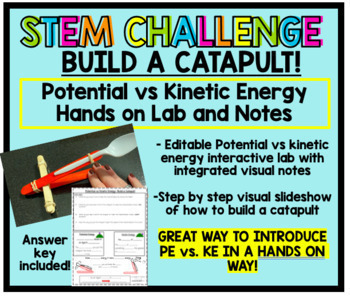Potential vs Kinetic Energy: Build a Catapult STEM Lab and Notes EDITABLE
- Google Slides™

What educators are saying
Description
Teach your students the difference between PE and KE through this fun STEM challenge of building a catapult! Use this for introduction to the concept or for reinforcement! Having a visual and a kinesthetic tool to build a foundation for a scientific concept ensures success in the classroom! Students got an absolute kick out of building and catapulting all while discovering the difference between potential and kinetic energy!
This purchase includes:
- Google Slideshow of visuals and step by step instructions of how to build a catapult to display for students
- Exploration lab note sheet with visuals and graphic organizer (I used this in my interactive notebooks by printing at 83%)
- Answer key included
In my lesson, we used mini marshmallows to put in our catapults. But, you can use puff balls, cotton balls, or even mini crumbles of paper! They were given time to explore and answer exploration questions while doing so. Afterwards, their exploration drove a student led class discussion to fill out their interactive visual notes as a class with teacher guidance.


